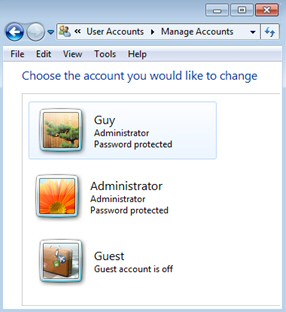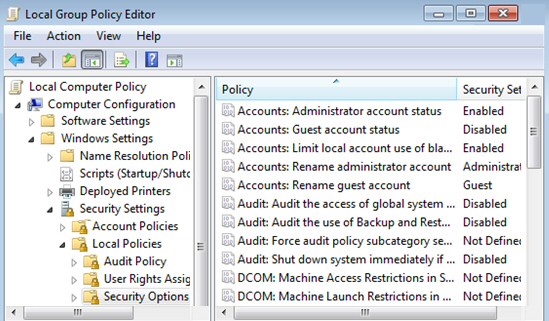How to Activate the Windows 7 Administrator – /Active:Yes
It’s a well kept secret that Windows 7 has a hidden super-user administrator account. I will show you how to activate this Windows 7 Administrator account from the command line by typing a ‘Net User’ command. One benefit of logging on with this super account is that you will never be prompted for the nagging UAC dialog box.
Topics for Activating the Windows 7 Administrator
- How to Activate Your Hidden Windows 7 Administrator
- Local Group Policy Method to Enable the Administrator Account
- Benefits of Windows 7’s Hidden Administrator Account
- Check Windows 7’s User Accounts
- Activate Administrator Windows 8
- Summary of Windows 7 Administrator – Super User (Hidden Account)
♦
How to Activate Your Hidden Windows 7 Administrator
Your first key decision is what password to give this administrator’s account before you activate it. My point is that the local group policy may insist on a complex password, thus you will not be able to activate the administrator account if it has a blank password. This technique also also works on Vista and Windows Server 2008, however, on the latter operating system it is more likely you want to set /active:no.
Overview
- Logon to Windows 7 using your usual account.
- Launch the cmd prompt – Make sure you select, ‘Run as administrator’
- Net user administrator p$ssw0rD
- Net user administrator /active:yes
- Switch User, or logoff
- Logon as Administrator Password p$ssw0rD
(Your password may be different!)
Detailed Instructions to activate the Administrator
- Logon to Windows 7 using another administrator’s username and password.
- Click on the Start button
- Click on Start Search.
- Type, cmd.
- Right-click cmd, select ‘Run as administrator’ from the shortcut menu.
- In the black ‘DOS box’, type the following at the command line:
Net help user - The idea of the last command is just to check the options for Net User. In particular, examine the syntax to set its password.
- The next instruction is the crucial command. I have chosen password = p@ssworD, you may want to choose different characters.
- Net user administrator p$ssw0rD
- Net user administrator /active:yes
- Check the message hopefully you get : The command completed successfully.
If not log on as a different administrator. - Switch User, or logoff
- Logon as Administrator Password p$ssw0rD (Your password should be different!)
Guy Recommends: A Free Trial of the Network Performance Monitor (NPM) v11.5
v11.5
SolarWinds’ Orion performance monitor will help you discover what’s happening on your network. This utility will also guide you through troubleshooting; the dashboard will indicate whether the root cause is a broken link, faulty equipment or resource overload.
What I like best is the way NPM suggests solutions to network problems. Its also has the ability to monitor the health of individual VMware virtual machines. If you are interested in troubleshooting, and creating network maps, then I recommend that you try NPM now.
Download a free trial of Solarwinds’ Network Performance Monitor
Troubleshooting Adminstrator /Active:Yes
Trap1 – Spaces: There should be no space between the word ‘active’ and the colon.
/active :yes (is wrong).
/active:yes (is correct).
Trap2 – Slash: You need a forward slash before the word thus: /active
Net user administrator active:yes is wrong
Net user administrator /active:yes is correct
I thank Rob Hilton for pointing out the above trap.
Trap3 – Be Active: Pay close attention to the command, it should be active, and not activate.
Thanks to Ben O’Sullivan for correcting this activate –> active error.
Local Group Policy Method to Enable the Administrator Account
Kindly sent in by Dave Waddell
If you prefer a simpler method, visit the Local Security policy, incidentally, this MMC is worth exploring in its own right.
This is how you navigate to the Local Security Policy.
Firstly click on Windows 7’s Start orb, then in the Start Search dialog box type: secpol.msc. Note: you must include the .msc extension.
Secondly drill down to Local Policy, Security Options
Thirdly double click Accounts: Administrator account status, and select enable.
You can also see the resulting Administrator in the Control Panel, User Accounts folder see below.
Check Windows 7’s User Accounts
Activating this super account provides a good opportunity to examine where you can configure Windows 7’s accounts. Click on the Start button, Control Panel and select –> User Accounts: My point is that you can check in the GUI which accounts have activated successfully. /Active:yes the account is visible. /active:no the User Name disappears from the list below.

Recommended: Solarwinds’ Permissions Analyzer – Free Active Directory Tool
I like the Permissions Monitor because it enables me to see WHO has permissions to do WHAT at a glance. When you launch this tool it analyzes a users effective NTFS permissions for a specific file or folder, and takes into account network share access, then displays the results in a nifty desktop dashboard!
Think of all the frustration that this free SolarWinds utility saves when you are troubleshooting authorization problems for user’s access to a resource. Give this permissions monitor a try – it’s free!
Download SolarWinds’ Free Permissions Analyser – Active Directory Tool
Benefits of Windows 7’s Hidden Administrator Account
One benefit of activating the hidden Windows 7 Administrator is that you have access to an account, which does not suffer from the annoying UAC dialog box. Although it is possible to suppress the UAC with a local group policy, there is a lingering fear that security is being weakened. Another worry is that rumours persist that some commands don’t work properly if you turn off the UAC.
Linked to the benefit of suppressing the UAC dialog box is the fact that this Administrator account has elevated privileges. What this means is that if your run CMD you don’t have to ‘Run as administrator’ before you get unrestricted access to the command line.
®


